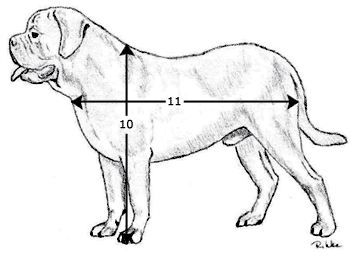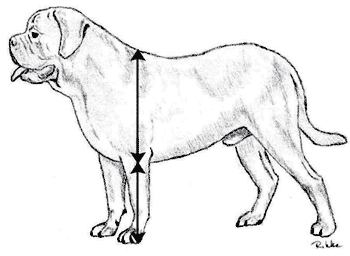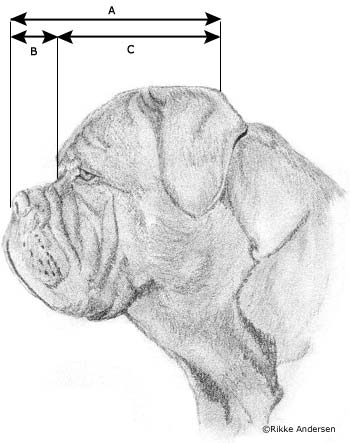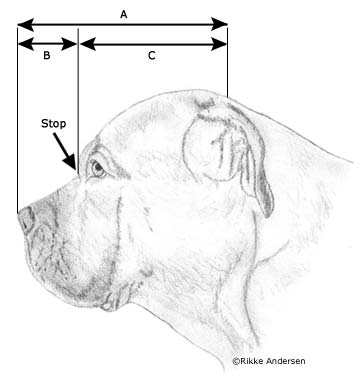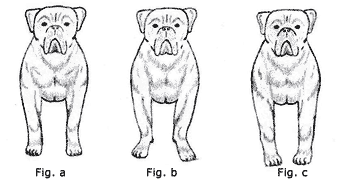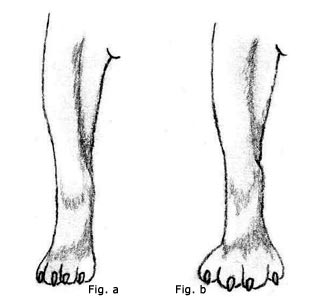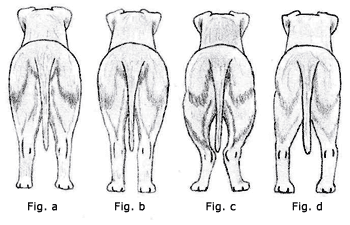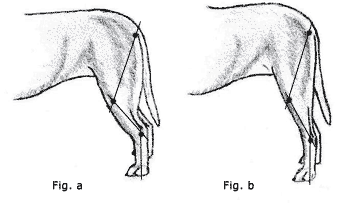|
| Home | The girls | The puppies | About me | History | Characteristic | Standard | Gallery | In memory | Guestbook |

|
- F.C.I Breed Standards Dogue de Bordeaux Utilization: Guard, defense and dissuasion. Important proportions: The length of the body is superior to the height at the withers, in the proportion of 11/10, measured from the point of the shoulder to the point of the buttock. The depth of the chest is more than half the height at the withers. The maximum length of the muzzle is equal to the third of the length of the head. The minimum length of the muzzle is equal to one quarter of the length of the head. In the male, the perimeter of the skull corresponds more or less to the height at the withers. Behavior/Temperament: An ancient fighting dog, the Dogue de Bordeaux is gifted for guarding, which he assumes with vigilance and great courage but without aggressiveness. A good companion, very attached to his master and very affectionate. Calm, balanced with a high stimulus threshold. The male normally has a dominant character. Faults: Hyper aggressive, timid. Head: Voluminous, angular, broad, rather short, trapezoid when viewed from above and in front. Faults: Head short and round with protruding eyes. Cranial region: In the male: the perimeter of the skull measured at the level of its greatest width corresponds roughly to the height of the withers. In bitches: it may be slightly less. Its volume and shape are the consequences of the very important development of the temporals, supraorbital arches, zygomatic arches and the spacing of the branches of the lower jaw. The upper region of the skull is slightly convex from one side to the other. Fronto-nasal depression or stop is very pronounced, almost forming a right angle with the muzzle (95 to 100). The frontal groove is deep, diminishing towards the posterior end of the head. The forehead dominates the face. However it is still wider than high. The head is furrowed with symmetrical wrinkles, each side of the median groove. These deep ropes of wrinkle are mobile depending on whether the dog is attentive or not. Faults: Hypertypical bull-doggy: flat skull, muzzle measuring less than a quarter of the total length of the head. Facial region/Muzzle: Powerfull, broard, thick, but not fleshy below the eyes, rather short, upper profile very slightly concave, with moderately obvious folds. Its width hardly decreasing towards the tip of the muzzle, when viewed from above it has the general shape of a square. In relation to the upper region of the skull, the line of the muzzle forms a very obtuse angle upwards. Nose: Broad, well opened nostrils, well pigmented according to the mask. Upturned nose (snubbed) permissible but not if it is set back towards the face. Disqualifying faults: Muzzle paralleled to the top line of the skull or downfaced, Roman nose. Jaws: Very powerful, broad. Undershot (the undershot condition being a characteristic of the breed). The back face of the lower incisors is in front of and not in contact with the front face of the upper incisors. The lower jaw curves upwards. The chin is well marked and must neither overlap the upper lip exaggeratedly nor be covered by it. Faults: Important lateral deviation of the lower jaw. Disqualifying faults: twisted jaws; Mouth not undershot. Teeth: Strong, particularly the canines. Lower canines set wide apart and slightly curved. Incisors well aligned especially in the lower jaw where they form an apparently straight line. Disqualifying faults: Canines constantly visibly when the mouth is closed; Tongue Constantly hanging out when the mouth is closed. Upper lip: Thick, moderately pendulous, retractile. When viewed in profile it shows a rounded lower line. It covers the lower jaws on the sides. In front the edge of the upper lip is in contact with the lower lip then drops on either side thus forming a reversed wide V. Cheeks: Prominent, due to the very strong development of the muscles. Eyes: Oval, set wide apart. The space between the two inner angles of the eyelids is equal to about twice the length of the eye (eye opening). Frank expression. The haw must not be visible. Colour, hazel to dark brown for a dog with a black mask, lighter colour tolerated but not sought after in dogs with either a brown mask or without a mask. Ears: Relatively small, of a slightly darker colour than the coat. At its set on the front of the ear is slightly raised. They must fall back, but not hang limply, the front edge being close to the cheek when the dog is attentive. The tip of the ear is slightly rounded; it must not reach beyond the eye. Set rather high, at the level of the upper line of the skull, thus appearing to accentuate its width even more. Neck: Very strong, muscular, almost cylindrical. The skin I supple, ample and loose. The average circumference almost equals that of the head. It is separated from the head by a slightly accentuated transversal furrow, slightly curved. Its upper edge is slightly convex. The well defined dewlap starts at the level of the throat forming folds down to the chest, without hanging exaggeratedly. The neck, very broad at its base, merges smoothly with the shoulders. Body/Topline: Solid with a broad and muscular back, withers well marked, broad loin, rather short and solid, rump moderately slopping down to the root of the tail. Chest: Powerful, long, deep, broad let down lower than the elbows: Broad and powerful breast who´s lower line (inter-axillae) is convex towards the bottom. Ribs well let down and well sprung but not barrel shaped. The circumference of the chest must be between 0,25 to 0.30 m. greater than the height at the withers. Underline: Curved, from the deep brisket to the rather tucked up, firm abdomen, being neither pendulous nor whippety. Tail: Very thick at the base. Its tip preferably reaching the hock and not below. Carried low, it is neither broken nor kinked but supple. Hanging when the dog is in repose, generally rising by 90” to 120” from that position when the dog is in action, without curving over the back or being curled. Faults: Fused by not vertebrae of the tail. Disqualifying faults: Tail knotted and laterally deviated or twisted (screw tail, kink tail); Atrophied tail. Limbs/Forequarters: Strong bone structure, legs very muscular. Faults: Forefeet turning inwards (even slightly); Forefeet turning outwards too much. Disqualifying faults: Fiddle front with splay feet. Fig. 5. Shoulders: Powerful, prominent muscles, Slant of shoulder blade medium (About 45” to the horizontal), angle of the scapular-humeral articulation a little more than 90”. Arms: Very muscular. Elbows: In the axis of the body, neither too close to the thoracic wall nor turned out. Forearms: Viewed from the front, straight or inclining slightly inwards thus getting closer to the median plane, especially in dogs with a very broad chest. Viewed in profile, vertical. Metacarpal region: Powerful. Viewed in profile, slightly sloping. Viewed from the front sometimes slightly outwards thus compensating for the slight inclination of the forearm inwards. Feet: Strong. Toes tight, nails curved and strong, pads well developed and supple: the Dogue de Bordeaux is well up on his toes despite his weight. Fig.6. Thigh: Very developed and thick visible muscles. Faults: Flat thighs. Hindquarters: Robust legs with strong bone structure: well angulated. Fig. 7 & 8. Stifle: In parallel plane to the median plane or slightly out. Leg: Relatively short, muscled, descending low. Hock: Short, sinewy, angle of the hock joint moderately. Metatarsus: Robust, no dewclaws. Hindfeet: Slightly longer than the front feet, toes tight. Movement: Quite supple for a molossoid. When walking the movement is free, supple, close to the ground. Good drive from the hindquarters, good extension of the forelegsEspecially when trotting, witch is the preferred gait. When the trot quickens, the head tends to drop, the topline inclines toward the front, and the front feet get closer to the median plane while striding out with a long reaching movement of the front legs. Short gallop with vertical movement rather important. Capable of great speed over short distances by bolting along close to the ground. Faults: Stilted movement or serious rolling rear; Excessive shortness of breath, rasping. Disqualifying faults: Identifiable disabling defect. Skin: Thick and sufficiently loose fitting. Hair: Fine, short and soft to the touch. Coat: Self-coloured, in all shades of fawn, from mahogany to Isabella. A good pigmentation is desirable. Limited white patches are permissible on the chest and the extremities of the limbs. Faults: White on tip of tail or on the front part of the forelegs, above the carpus and the tarsus. Disqualifying faults: White on the head or body, any other colour of the coat than fawn. Size: Height should more or less correspond to the perimeter of the skull. Dogs: 60-68 cm at the withers; Bitches 58-66 cm at the withers. 1 cm under and 2 cm over will be tolerated. Mask: (1.) Black mask: the mask is often only slightly spread out and must not invade the cranial region. They may be slight black shading on the skull ears, neck and top of the body. (2.) Brown mask: (used to be called red or bistre) the nose is then brown, eyerims are also brown. (3.) No mask: the coat is fawn: the skin appears red (also formerly called “red mask”). The nose is the reddish or pink. Weight: Dogs: at least 50 kg. Bitches: at least 45 kg. Bitches: Identical characteristics but less prominent. NB: Male animals should have two apparently normal testicles fully descended into the scrotum. Faults: Any departure from the foregoing points should be considered a fault and should be penalized in proportion to its degree. |
||||
|
|
||||
|
|
||||||||||||||||||||||||||||||||||||||||||||||
